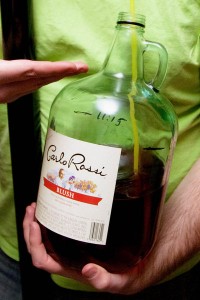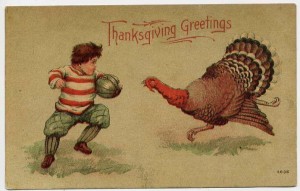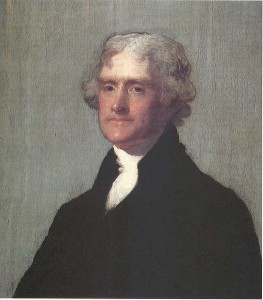The following is a guest post written by Marlene Rossman. See her bio at the end of this post. You may also find her on Facebook by clicking here.
We in America, declared Thomas Jefferson in 1808, can make wine “doubtless as good” as the great wines of Europe. No one at that time promoted wine more enthusiastically than Jefferson. “Good wine,” he once said, “is a daily necessity.” Jefferson was also one of America’s first “foodies.” He imported both macaroni and Parmesan cheese for his own use in 1802, when both were unknown in the U.S., and Jefferson even served a “macaroni pie” at a state dinner.
Jefferson, who was third President of the United States (1801–1809), would have been thrilled to see the development of the American wine industry in the
21st century. He would likewise have been delighted to see how the quality of food has developed/evolved. And he would have been lifted to the heavens to have a meal with American wine and food that are both equal to or better than any other place in the world.“There is no love sincerer than the love of food,” said Irish dramatist George Bernard Shaw.
Over the last 30+ years, the U.S. has moved from a tuna casserole, soda pop and martini society to a developing wine culture, with the number of Americans who report they drink wine increasing rapidly. California, Washington, Oregon and even New York wines are now considered first rate. Along with the rise of American wine, America’s food culture is also changing for the better, as seen proliferation of ethnic cuisine and cross-cultural combinations, like Mexican/Korean or Japanese/French, and unusual “gastro-fusion” dishes that have found their way into the mainstream.
The American food and wine revolution is starting emerge in every grocery store and fast-food restaurant in big and little cities all over the U.S. of A. Foods our grandparents never heard of are now standard fare: sushi, tofu, chipotle, arugula, Parmagiano Reggiano, EVOO!
We have no real history intertwining our wine and food in America. But today, we can cook good food anywhere and we make wine in all 50 states. It is no accident that America’s food and wine have changed together. A glass of wine can lift a mundane dish to the magical. A dish as simple as roasted cauliflower topped with goat cheese becomes regal when paired with a glass of California Sauvignon Blanc. Foodies love good wine, and wine lovers appreciate great food.
The U.S. is a land of immigrants and our food history is a mish-mash of influences from our collective European, Asian, African and Latin American heritage. And the influence on food after World War two was the transformation of our agricultural economy to an industrial one, as the familiar foods we ate in the second half of the 20th century were more manufactured than grown. Have a look at “American cheese,” which many of us grew up on. The slimy, shiny cheese was created in a lab, not in a cave or a cellar. American food at that time used to be Kraft Mac & cheese, but in the last 30 years, we went from Kraft Food to craft food!
Unlike Europe, the U.S. does not have a long history of winemaking or wine drinking. In fact, it wasn’t until the Judgment of Paris in 1976 where California

By flickr user pinguino [CC-BY-2.0 (http://creativecommons.org/licenses/by/2.0)], via Wikimedia Commons
Today, farmer’s markets are now fixtures all over the land and proliferating. Although 90% of all wine produced in the U.S. is from California, the Pacific Northwest has embraced the locally-grown movement, and its newfound awareness is definitely linked to the growth of wine production in Oregon and Washington State.
Just as American wine was beginning to gain recognition, Alice Waters opened her Chez Panisse restaurant in Berkeley in 1971. By 1978, the French Laundry opened, signaling the beginnings of a new level of cuisine in Napa Valley, and creating a model for the rest of the country.
By the mid-1980s on the East Coast, Danny Meyer opened his signature restaurant, Union Square Café, in Manhattan. The restaurant was one of the first “new American” restaurants in New York. Meyer sourced much of his produce from the first New York City Greenmarket, and the crowds came. Among other early adopters of the farm-to table movement were Alfred Portale and Mario Batali.
Before that, on the East coast, dining out was mostly at pretentious French restaurants that insisted on formal dress in order to gain entry. But, like the West Coast, the East coast has become “American forward” when it comes to dining and even drinking. Smith & Wollensky, a highly- regarded steakhouse in Manhattan was the first New York restaurant to feature American wines exclusively, opting out from offering imported wine, in 2003.
Thanks in part to America’s 40-year interest in fine wine, which I believe led to the revolution in the foods we now eat— witness the Food Channel— and even network restaurant shows, a growing number of us are cooking and eating better and more interesting food.
Now, back to our traditional Thanksgiving programming, as I must select wines to pair with turkey, ham and (terribly tannic) cranberry sauce, and of course, dear old Aunt Ethel’s stuffing. Happy Holidays!
© 2012 Marlene Rossman

Source: http://upload.wikimedia.org/wikipedia/commons/7/7e/Thanksgiving_1900.JPG Under Public Domain
According to her bio, “Marlene is the wine columnist for Chef magazine and writes on wine for Andy Dias Blue’s Tasting Panel, Sommelier Journal and International Sommelier magazines. She was the Editor-in-Chief and columnist for Wine Country International magazine, wine columnist/editor for Orange County Home, New York’s Flatiron magazine and wrote for Beverage Media, and Wine Business Monthly. She was the featured commentator with Stephen Spurrier, in a program on “American Wine” produced by Associated Press Television News. She is a member of the North American Sommelier Association.” She is a former sommelier and currently the distinguished instructor of wine at UC-Irvine.

